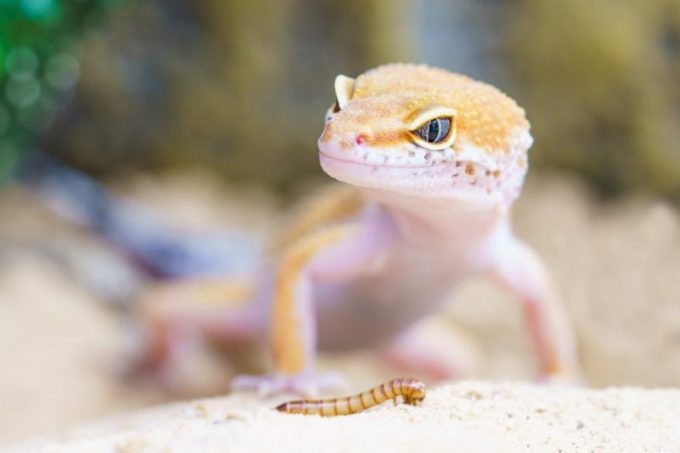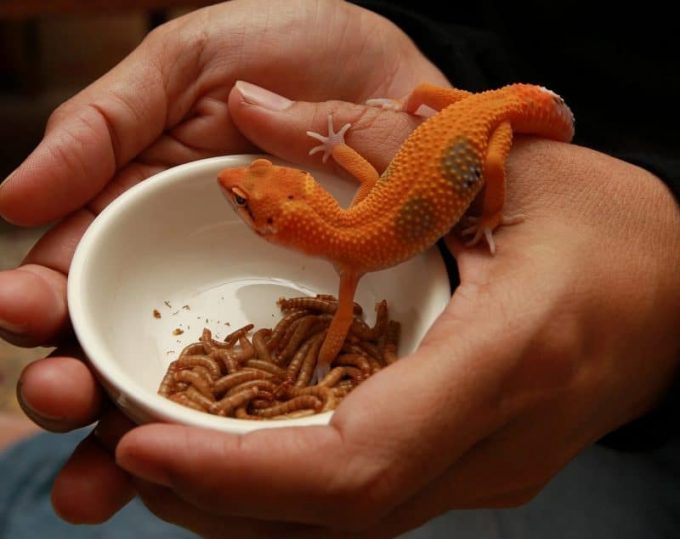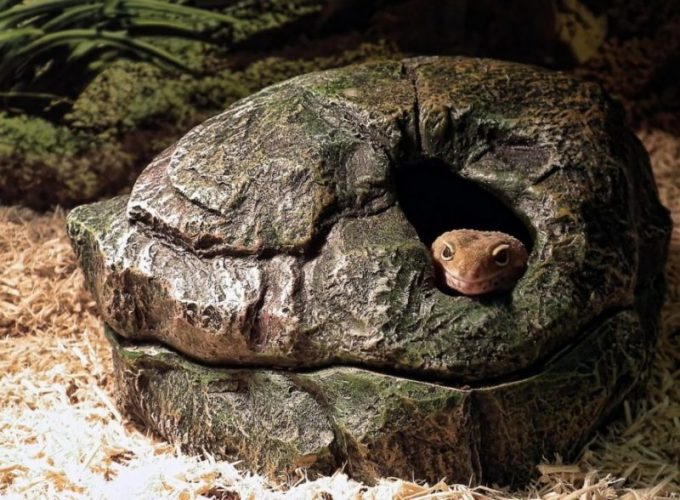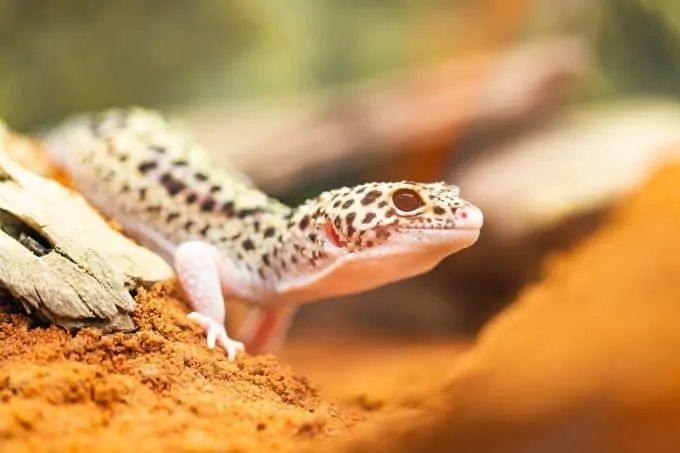Can reptiles feel true happiness?
We can’t really know. If they do, it is probably quite different from the human version of happiness.
However, we do have some things in common.
You can’t feel happy if you are hungry, thirsty, cold, or in pain, right? Satisfying those basic needs is a precondition for achieving happiness in humans.
The same is with other creatures, including leopard geckos.
So, while we cannot know the true nature of gecko happiness, we can certainly say that being fit, healthy, well-fed, and alert and is an equivalent of “happiness” in the world of leos.
How to tell if your leo is really satisfied? Let’s learn some basic signals of leo’s happiness and unhappiness.
Signs That Show Your Leopard Gecko Is Happy
Here are some signs that tell you that your leopard gecko is in a happy mood and good health:
- He looks bright and alert.
- He has a good appetite.
- He moves effortlessly and smoothly.
- He reacts to being touched.
- He reacts to movements inside and outside of the tank, especially when hungry.
- He approaches the front glass when he is hungry and he sees you.
- He explores his tank.
- He spends some time in the warm spot and some time in a cool hide – balancing his body temperature.
To point out once again – the signs of a healthy gecko are signs of a “happy” gecko.
> Read more: The Leopard Gecko Behavior (Common & Unusual)
Signs That Show Your Leopard Gecko Is Unhappy
“Unhappiness” might be hard to pinpoint and define in geckos. We have no way of measuring it.
Also, reptiles are good at putting up with pain, so they may not show signs of unhappiness and distress as soon as something starts to go wrong.
However, there some red flags that show that your leo might be feeling miserable, and you should respond to them immediately.
Lethargy and sluggishness
Unwillingness to move, moving slowly, unresponsiveness. Lethargy should not be mistaken for a lot of healthy sleep (see below).
Lack of appetite
Lizards love to eat – this fact is reflected in their hunting enthusiasm, and by the sheer number of chubby or even obese pets you can see online.
Lack of appetite is one of the most common signals of poor health, an injury, or a tank that is too cold. If your leo has just gone on hunger strike, pay attention if he’s passing any stools and give him a warm bath if there is no sign of bowel movement – he might be blocked.
If the issue continues, don’t waste any time and take your pet to the vet.
Eyes closed too often, even when awake
This sign often co-occurs with sluggishness and can have similar underlying causes. There is one additional option to consider though – check if the lights are too bright and adjust if needed.
Quick and jerky movements
Quick and jerky movements signal fear, and fear provokes stress. If your gecko shows these signs while he on an excursion outside of the tank, it is time to put him back.
Tail waving
Tail waving is a sign that basically says “Leave me alone.”
If your leopard gecko is doing the wave when you want to handle him, it is better to take his advice and indeed leave him be.
These are all stress and health-related signs. That is why they overlap with the symptoms that reveal that a gecko might be stressed or sick.
Sleeping in Leopard Geckos
You may notice that your leopard gecko is sleeping a lot, and you may be worried if this is the same as being lethargic. Here’s the good news: it is not. As crepuscular animals that are truly active for a short period of the day, leopard geckos tend to sleep a lot.
There is one big difference between a sick and a healthy leo when it comes to sleeping.
When you awake your healthy sleeping leo by touching him or provoking him with some food, he will become alert and interested almost immediately.
However, an unhappy or sick lizard will not bother to move, or if he does, it will be obviously difficult for him. That is when we say that he is “lethargic.”
Are Leopard Geckos (Un)Happy in Captivity?
Leopard geckos we keep today have been bred for generations in captivity.
While they have gained many awesome new colors, they must have lost some of their natural habits. So it is safe to assume that captive leopard geckos don’t miss being wild. As long as you have their basic needs covered, they will thrive.
However, it is tough to say if geckos who are healthy and well-fed, but understimulated (e.g., by living in a completely dull, unnatural environment like breeding racks) feel “unhappy.” For now, we don’t have a way of knowing. I would always err on the safe side and provide a terrarium setup that is as natural as possible.
How Do I Know If My Leopard Gecko Is Stressed?
Stress is a reaction to unfavorable or dangerous conditions.
Some of the really obvious signs of a stressed leo are frantic movements, tail wagging, glass surfing, jerky movements, vocalizing when handled, hunger strike. We have covered a lot of these in Section 2.
For more, please check out the Leopard Gecko Stress Signs article.
Do Leopard Geckos Like to Be Handled?
Leopard geckos are one of the lizards that can be handled without causing them stress.
However, it doesn’t mean that they need to be handled. Depending on the leo’s little personality, they will either like it in moderation or simply tolerate it.
Here’s a real-life example. My gecko Mia doesn’t like being handled too much. She will often try to jump out of my hands and will be all squirmish in general. The other female, Sonya, is much more docile. She loves the warmth of my hands and I can swear she enjoys me stroking her head and neck.
Geckos love warm hands. If you’re warm, they will enjoy that time on the palm of your hand much more.
You will need to start to handle your gecko as a juvenile to get him used to be picked up and held. Start getting them used to it inside of their vivarium.
Once you’ve conquered that, you can move your pet to the outside environment and hold him above a soft surface such as the bed.
Do Leopard Geckos Get Lonely?
Leopard geckos are not social creatures. Their brains literally lack the parts that are related to social life. If you are not social, you don’t need company; and if you don’t need company, you can’t get lonely.
Although leos are not extremely solitary to the point that they will suffer if they share their space with other members of the species, it is much safer to keep one gecko per tank than to have multiple geckos.
Even if they get along fine in what is considered a safe combination (e.g., two females), things are sure to get tense at feeding time. Every time. Biting incidents will occur.
That is why we do not encourage or recommend cohabitation. It is not the best practice when it comes to keeping lizards, leos included.
Do Leopard Geckos Get Bored?
We can’t truly know if leos can feel anything like boredom. However, because they are predators, we can rightfully assume that they do get a kick out of hunting.
If you want to take your leo ownership to another level and add natural stimulation, ensure they have occasions when they have to chase their prey around instead of just munching it from a tray.
Alternatively, move mealworms or other food items around the tank with a pair of feeding tweezers.
A word of caution. Some roaches like Dubia roaches might “freeze” or burrow to avoid being eaten. They may remain in a tank for a long time unnoticed – and uneaten.
Others like Turkeistan roach can be quick to escape the tank.
And crickets are well-known as escape artists and nasty biters. Never leave crickets in your leo tank unattended!
If your pet is not interested after a while, remove the remaining crickets from the tank.
Do Leopard Geckos Get Attached to Their Owners?
The question if leopard geckos can get attached to you is a tricky one. As I said earlier, leos are not social creatures, even when it comes to the members of their own species.
“Attachment” is something that occurs in social animals, and no reptile species falls into that category as far as we know.
However, through feeding, stroking and other pleasant activities, a gecko will learn that you are his friend. That is why, in time, he will start reacting to you in a neutral or a positive way.
Take Care!
Have you enjoyed learning about happiness in leopard geckos?
All enthusiastic reptile owners strive to figure out the mysteries of reptile happiness. I’m no different, so this is a great topic to revisit once in a while and discover something new about what can make your pet reptile happy or unhappy. Because there is no point in keeping reptiles if the pleasure is not mutual!
How do you ensure that your leo is happy? Do you ever get any dilemmas? Feel free to post a comment about it!






13 Comments
Hi this might not be the right place for this but my gecko has been hiding from me a lot recently and I was wondering if it is she is in their form of hibernation or something else as I am a tad worried, if you see this thank you for your input! (My name will be my gecko’s)
Hi Gojira’s owner,
You haven’t told us if there are any other issues or symptoms with your gecko other than hiding. Low activity due to hibernation usually begins in late autumn or early-mid winter – I’d say it’s a bit too late for that.
Here are a few other ideas.
– Keep the temperatures in check, and if they’re not at the highest, bring them up a little bit.
– Is the lighting too bright? Does your leo become active when you turn the lights off?
– Has he eaten too much recently, or was perhaps accidentally hurt by a strong-jawed prey insect such as a cricket or a superworm?
I hope all is well with your pet now.
Cool name btw 🙂
My gecko gets happy when I get home. It is probably that the dogs get happy and he sees the movement but he always pokes his head out of the hide when I come in.
Great article I have a leapord gecko she is wonderful her name is Oreo I have only had her for a month and she just shed witch was cool
Thank you so much! I currently have a Leopard Gecko and I just want to make sure that I’m doing my best to take care of him and actually make sure he has a good life. This article was very informational and very, very helpful. Again thank you!!
How long should it take to shed its skin? It seems a little too long, more than a couple weeks?
Hi Lucy,
This reply is definitely long overdue – sorry about that – but perhaps it will be useful to someone.
You didn’t write how old is the leo, but the truth is they don’t have a particular shedding schedule. Younger individuals shed more frequently because they grow fast – yes, even every 1-2 weeks. Adults shed only once in a few months.
If you have a baby or a juvenile that hasn’t been shedding for two weeks on more, keep an eye on the feeding, supplementation, and tank temperatures and make sure that each of the factors (that could affect growth) is optimal and that there are no signs of parasites. After ensuring everything’s fine, give it a week or two.
If your gecko is an older juvenile or already an adult, more than couple of weeks between shedding is completely normal.
Very helpful and well said!!! Thank you 🙂
This article really helped me make my leperd gecko happy
This was the best article ever! Its given me so much information that now i dont have to keep looking up signs if my gecko is healthy or unhealthy!
thank you so much! Now I’m allowed to get a gecko! :DDDDD
Best article ever. Thank you. Thank you. Thank you. You are amazing.
My grandson has a rather large leopard gecko with what looks like a “fat” tail. He seems very happy, per your interesting article. I am very proud of him for giving such good care. Apollo is a fun little creature to interact. THANK YOU for your article, Nana xo